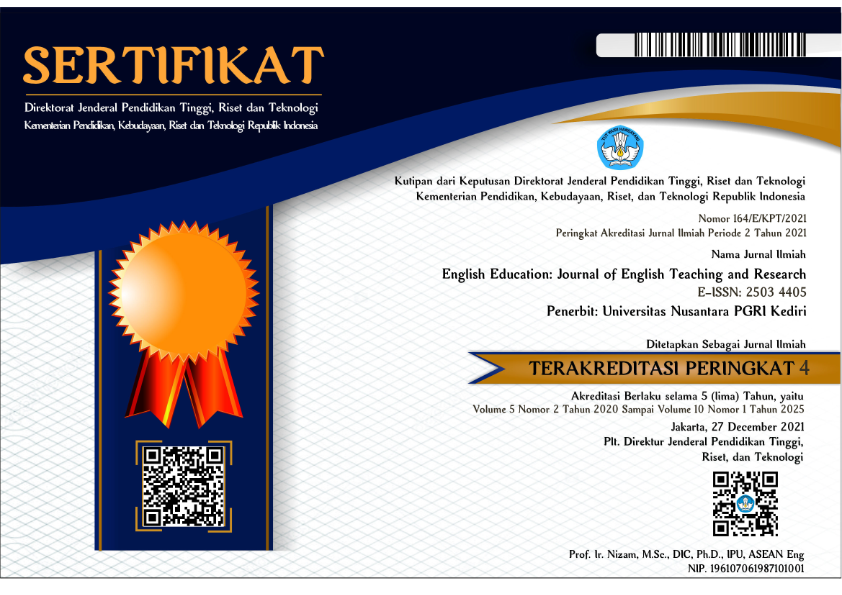Code Switching Preferences and Necessities in EFL Learners
A Literature Review
DOI:
https://doi.org/10.29407/jetar.v9i1.22447Keywords:
EFL learners, Code-Switching, LinguisticAbstract
This study examines why EFL learners in Indonesia often switch between their English to native language when talking, primarily their reasons to do so whether itsnecessities or preferences. The research method is done through a systematic literature review from numerous previous studies of journal and thesis that are found in Google Scholar using search engine Publish or Perish 8.The results obtained are fascinatingly diverse from their own reasons to their environment, for example habits, shyness, and following today’s social trends.The findings emphasize the complexity of EFL learners' code-switching. This article aims to provide valuable insights into the linguistic phenomenon of Code-Switching. This information is intended to be useful for both language educators and learners alike, and has suggestions such as Vocabulary Enchancement Strategies, Awareness and Education etc.
Downloads
References
Auer, P., & Eastman, C. M. (2010). Code-switching. Society and language use, 7, 84.
Appel, R., & Muysken, P. (2005). Language contact and bilingualism. Amsterdam University Press.
Bourdieu, P. (1991). Language and symbolic power. Harvard University Press.
Cenoz, J. (2003). The additive effect of bilingualism on third language acquisition: A review. International Journal of Bilingualism, 7(1), 71-87.
Dörnyei, Z. (2005). The Psychology of the Language Learner: Individual Differences in Second Language Acquisition (1st ed.). Routledge.
Gardner-Chloros, P. (2009). Code-switching. Cambridge: Cambridge University Press.
Genesee, F. (2001). Bilingual first language acquisition: Exploring the limits of the language faculty. Annual review of applied linguistics, 21, 153-168.
Kitchenham, B. (2004). Procedures for performing systematic reviews. Keele, UK, Keele University, 33(2004), 1-26.
MacSwan, J. (2000). The architecture of the bilingual language faculty: Evidence from intrasentential code switching. Bilingualism: language and cognition, 3(1), 37-54.
Muysken, P. (2000). Bilingual speech: A typology of code-mixing. Cambridge: Cambridge University Press.
Otheguy, R., García, O., & Reid, W. (2015). Clarifying translanguaging and deconstructing named languages: A perspective from linguistics. Applied Linguistics Review, 6(3), 281-307.
POPLACK, S. (1980). Sometimes I’ll Start a Sentence in Spanish Y TERMINO EN ESPAÑOL: toward a typology of code-switching. Linguistics, 18(7-8), 581-618.
Salleh, N., Mendes, E., & Grundy, J. (2011). Empirical studies of pair programming for CS/SE teaching in higher education: A systematic literature review. IEEE Transactions on Software Engineering, 37(4), 509-525.
Thorne, S. L. (2003). Artifacts and cultures-of-use in intercultural communication. Language Learning & Technology, 7(2), 38–67.
Telles, J. A. (2019). Multilingualism in the digital age: A global perspective. Bristol, UK: Multilingual Matters.
Wei, L. (Ed.). (2020). The bilingualism reader. Routledge.
Wardhaugh, R. (2006). Sociolinguistics. Victoria: Blackwell Publishing.
Saputra, S. (2023). Code-Mixing and Code-Switching in the English as a Foreign Language Classroom Activities. International Journal of Advanced Research in Education and Society, 5(3), 406-418.
Wigati, S. A., & Puspo, N. A. (2023). ANALYZING THE FACTORS BEHIND CODE-SWITCHING BY PETRA CHRISTIAN UNIVERSITY’S ENGLISH DEPARTMENT STUDENTS. UC Journal: ELT, Linguistics and Literature Journal, 4(1), 38-50.
Setyowati, Y. (2023). Navigating The impacts of Code-Switching in ESP Instruction: insights from lecturers and students. Indonesian EFL Journal, 9(2), 123-132.
Patmasari, A., Agussatriana, & Kamaruddin, A. (2022). An Investigation of the Use of Code-Switching in EFL Classroom: Attitudes and Perceptions. ELS Journal on Interdisciplinary Studies in Humanities, 5(2), 230-239.
Abdulloh, A. (2021). The Students’ Perception towards Code-Switching and Code-Mixing in Sociolinguistic: A Case at an English Education Major. EDUCATION AND LINGUISTICS KNOWLEDGE JOURNAL, 3(1), 24 - 38.
Maidah, A. N., & Nahrowi, M. (2022). Code Switching in English Teaching Learning Process at Year Tenth Of State Islamic Senior High School 3 Jember. FALASIFA: Jurnal Studi Keislaman, 13(02), 144-156.
Fahira, I. (2022). Code Switching in EFL Classroom: The Uses, the Types, and the Influences on English Learning (Doctoral dissertation, UIN Ar-Raniry).
Irawan, D. (2022). An Analysis of the Use of Code Switching in the Students' Conversation. Scope: Journal of English Language Teaching, 6(2), 62-66.
Sianipar, Y. O., & Tambunsaribu, G. (2022). The Use of Code Switching and Code Meshing in Today's Youth Speech. Jurnal Bahasa, Sastra, dan Budaya, 9(1), 9-20.
Masna, Y. (2020). EFL learners’ code-switching: Why do they switch the language? Englisia: Journal of Language, Education, and Humanities, 8(1), 93-101.
Sari, N. F. (2022). Code Switching and Code Mixing in Classroom Presentation of Indonesian EFL Students. EDUCASIA: Jurnal Pendidikan, Pengajaran, dan Pembelajaran, 7(2), 91-120.
Dwiyana, S. F. (2024). Students' Perception on the Use of Code-Switching in Oral Presentation (Doctoral dissertation, UIN Ar-Raniry Banda Aceh).
Sulianur, S., Qalyubi, I., & Sabarun, S. (2022). The use of code-switching and code-mixing inpublic speaking class at higher education islamic. PROJECT (Professional Journal of English Education), 5(4), 806-8016.
Ghani, M. B. A. (2023). EFL Students’ Perception Towards Code-Switching in Speaking (Doctoral dissertation, Universitas Islam Negeri Ar-Raniry).
Purnama, V. (2020). The perception of efl students to the use of code-switching in classroom. SPHOTA: Jurnal Linguistik dan Sastra, 12(2), 48-57.
Downloads
Published
Issue
Section
License
Copyright (c) 2024 Harnef Uyat Sentomoy

This work is licensed under a Creative Commons Attribution-ShareAlike 4.0 International License.
Authors who publish with this journal agree to the following terms:
- Copyright on any article is retained by the author(s).
- The author grants the journal, the right of first publication with the work simultaneously licensed under a Creative Commons Attribution License that allows others to share the work with an acknowledgment of the work’s authorship and initial publication in this journal.
- Authors are able to enter into separate, additional contractual arrangements for the non-exclusive distribution of the journal’s published version of the work (e.g., post it to an institutional repository or publish it in a book), with an acknowledgment of its initial publication in this journal.
- Authors are permitted and encouraged to post their work online (e.g., in institutional repositories or on their website) prior to and during the submission process, as it can lead to productive exchanges, as well as earlier and greater citation of published work.
- The article and any associated published material is distributed under the Creative Commons Attribution-ShareAlike 4.0 International License








 Article template
Article template



